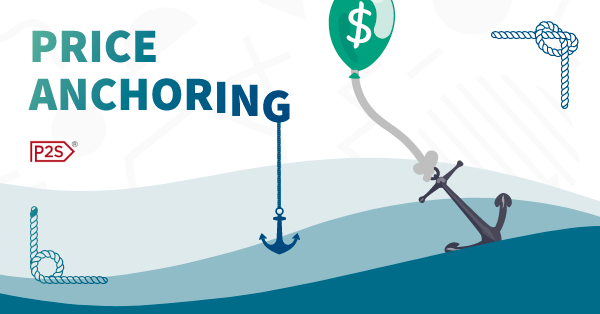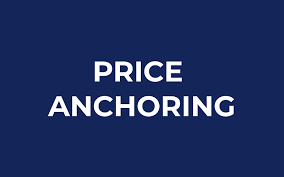Mastering the Art of Anchoring in E-Commerce Pricing: A Guide to Boost Sales and Influence Perceived Value

Introduction: Demystifying the Concept of Anchoring
Pricing is an art as much as it is a science. In the realm of e-commerce, pricing strategies can greatly influence consumer decisions. One such strategy, anchoring, is a psychological concept that can have a profound impact on how customers perceive value.

In this blog, we'll unravel the concept of anchoring, delve into its application in e-commerce, and equip you with practical steps to leverage it effectively in your pricing strategies.
What is anchoring?
Anchoring is a cognitive bias that affects our decision-making process. It occurs when people rely heavily on the first piece of information they encounter when making decisions. This initial information, known as the anchor, becomes a reference point that significantly influences how individuals assess value and make choices.
Example in E-Commerce: Influencing the Perception of Value
In the world of e-commerce, anchoring is a commonly used technique. Consider this example:
You're shopping online for a new pair of headphones, and you come across two options. The first pair is priced at $299, while the second pair is presented as "originally $499, now on sale for $299." The initial higher price of $499 acts as an anchor, framing your perception of value. As a result, the $299 price tag seems like an exceptional deal, even though it might be somewhat arbitrary or unrelated to the actual cost of production.
Action Items: Applying Anchoring in Pricing
To effectively use anchoring in your e-commerce pricing strategies, follow these practical steps:
Establish an Anchor Price: Start by defining an anchor price for your product. This can be the original price, a competitor's price, or a strategically chosen figure that sets the tone for the product's value.
Highlight Discounts and Savings: When offering discounts or promotions, emphasize the savings compared to the anchor price. Clearly communicate how much customers can save, reinforcing the perceived value.
Leverage Bundle Pricing: Create product bundles that showcase the combined value of the items. The anchor price can be used to highlight the perceived savings when buying the bundle.
Tiered Pricing: Implement tiered pricing options that include the anchor price as a reference point. This allows customers to make easy comparisons and select the most suitable option.
Visual Representation: Utilize visual elements such as strikethroughs or side-by-side comparisons to visually demonstrate the difference between the anchor price and the current price.
Dynamic Pricing Strategies: Consider implementing dynamic pricing based on customer segments, capitalizing on anchoring effects to cater to different consumer preferences.
Continuous Testing: Regularly conduct A/B tests to determine which anchor prices work best for your specific audience and products.
Educate Customers: Communicate the reasons behind your anchor price, whether it's related to product quality, unique features, or added benefits, to justify the perceived value.
Adapt to Market Conditions: Be flexible in adjusting your anchor price to remain competitive as market conditions change.
Maintain Honesty and Transparency: Always practice ethical and honest pricing. Deceptive practices can have a detrimental impact on your brand's reputation. Anchoring should be used to enhance value perception, not to mislead customers.
Conclusion: Unleash the Potential of Anchoring in Pricing
Understanding the power of anchoring in pricing is an essential tool for e-commerce businesses. By strategically using anchor prices to shape customer perceptions of value, you can enhance your pricing strategies and drive higher sales. Anchoring, when applied thoughtfully, can be a valuable asset in the competitive landscape of e-commerce.
FAQs
1. What is anchoring in pricing, and how does it work?
- Anchoring in pricing is a psychological concept where people rely heavily on the initial information or reference point they encounter when making purchase decisions. It influences their perception of value.
2. How can anchoring be applied in e-commerce pricing strategies?
- In e-commerce, anchoring can be applied by setting an anchor price, offering discounts relative to that price, using visual cues, and creating tiered pricing options, among other strategies.
3. Are there different types of anchor prices that can be used?
- Yes, anchor prices can be original prices, competitor prices, suggested retail prices, or strategically chosen figures that serve as reference points for consumers.
4. Does anchoring work in both online and physical retail environments?
- Yes, anchoring is effective in both online and physical retail settings. It influences consumer behavior and decision-making regardless of the sales channel.
5. Can anchoring be used unethically to deceive customers?
- While anchoring can be a powerful tool, using it unethically to mislead customers is not advisable. Honesty and transparency are crucial to maintain trust.
6. How do I choose an appropriate anchor price for my products in e-commerce?
- Select an anchor price that reflects the perceived value of your product and consider factors like production costs, market research, and competitors' pricing.
7. What are some practical ways to visually represent anchoring in e-commerce pricing?
- Visual cues such as strikethroughs on original prices, side-by-side comparisons, and highlighting the savings in dollars or percentages can effectively represent anchoring.
8. Can anchoring be used in combination with other pricing strategies?
- Yes, anchoring can be combined with various pricing strategies, such as bundling, dynamic pricing, and loyalty programs, to enhance their effectiveness.
9. How can I determine if my anchoring strategies are working effectively in my e-commerce business?
- A/B testing and analyzing sales, conversion rates, and customer feedback are effective ways to assess the success of your anchoring strategies.
10. Are there industries or products for which anchoring is particularly effective in pricing strategies?
- Anchoring can be effective in various industries, particularly for products with perceived value differences and in highly competitive markets, such as electronics, fashion, and luxury goods. However, it can be adapted to suit many different product categories.